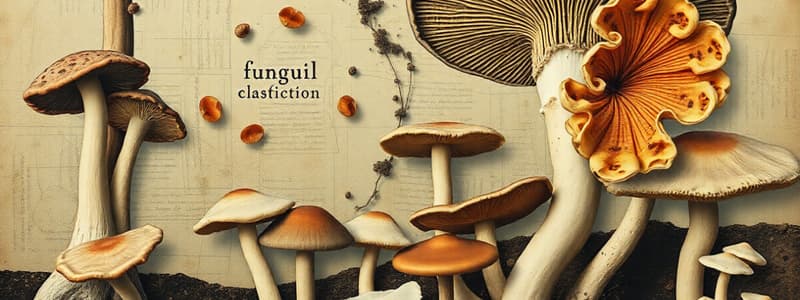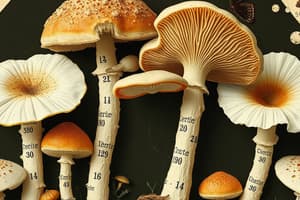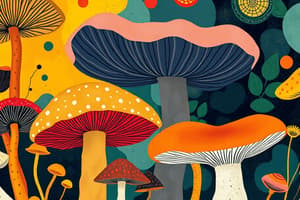Podcast
Questions and Answers
In which group are fungi phylogenetically classified?
In which group are fungi phylogenetically classified?
- Amorphea (correct)
- Plantae
- Bacteria
- Archaea
Fungi have a closer evolutionary relationship with land plants than with animals.
Fungi have a closer evolutionary relationship with land plants than with animals.
False (B)
What is the primary method through which fungi obtain their nutrients?
What is the primary method through which fungi obtain their nutrients?
- Photosynthesis
- Absorptive nutrition through external digestion (correct)
- Chemosynthesis
- None of the above
What are the three synapomorphies of fungi?
What are the three synapomorphies of fungi?
Fungi obtain nutrients through a process known as __________ nutrition.
Fungi obtain nutrients through a process known as __________ nutrition.
Fungi can digest cellulose and lignin found in plant materials.
Fungi can digest cellulose and lignin found in plant materials.
Match the following characteristics with their descriptions:
Match the following characteristics with their descriptions:
What are hyphae?
What are hyphae?
What role do most fungi play in their environments?
What role do most fungi play in their environments?
Fungi primarily acquire nutrients by growing and forming a network called ______.
Fungi primarily acquire nutrients by growing and forming a network called ______.
All fungi are unicellular organisms.
All fungi are unicellular organisms.
Which of these statements about yeasts is true?
Which of these statements about yeasts is true?
What type of cell walls do pathogenic yeasts have?
What type of cell walls do pathogenic yeasts have?
Fungi are motile organisms that can move toward nutrients.
Fungi are motile organisms that can move toward nutrients.
What is the role of exoenzymes in the digestive process of fungi?
What is the role of exoenzymes in the digestive process of fungi?
Match the following structures/terms to their descriptions:
Match the following structures/terms to their descriptions:
Which structure enhances nutrient absorption in fungi?
Which structure enhances nutrient absorption in fungi?
Hyphae of coenocytic fungi are divided into separate cells with walls.
Hyphae of coenocytic fungi are divided into separate cells with walls.
What polymer is found in the cell walls of fungal hyphae?
What polymer is found in the cell walls of fungal hyphae?
Fungi reproduce by creating and dispersing high quantities of ______.
Fungi reproduce by creating and dispersing high quantities of ______.
Match the type of fungal reproduction with its characteristic:
Match the type of fungal reproduction with its characteristic:
What type of hyphal structure allows for cell-to-cell movement of molecules?
What type of hyphal structure allows for cell-to-cell movement of molecules?
All fungi exclusively use asexual reproduction throughout their life cycle.
All fungi exclusively use asexual reproduction throughout their life cycle.
What type of hyphae are characterized by numerous nuclei dispersed throughout without cell division?
What type of hyphae are characterized by numerous nuclei dispersed throughout without cell division?
Which process is involved in the formation of fungal spores?
Which process is involved in the formation of fungal spores?
Fungi reproduce exclusively through sexual reproduction.
Fungi reproduce exclusively through sexual reproduction.
What are the two unique stages in the life cycle of fungi that involve nuclear fusion?
What are the two unique stages in the life cycle of fungi that involve nuclear fusion?
Fungal spores have cell walls rich in __________ for rigidity and protection.
Fungal spores have cell walls rich in __________ for rigidity and protection.
Match the following stages of fungal reproduction with their description:
Match the following stages of fungal reproduction with their description:
Which organism is known to rely strictly on asexual reproduction?
Which organism is known to rely strictly on asexual reproduction?
Fungi have a diploid, multicellular stage that is permanent.
Fungi have a diploid, multicellular stage that is permanent.
From what type of organism did fungi likely originate?
From what type of organism did fungi likely originate?
What unique feature distinguishes chytrids from other fungi?
What unique feature distinguishes chytrids from other fungi?
Fungi can be classified into four phyla.
Fungi can be classified into four phyla.
What is the estimated total number of fungal species that may exist?
What is the estimated total number of fungal species that may exist?
Chytrids belong to the phylum ______.
Chytrids belong to the phylum ______.
Which of the following phyla includes fungi that are known as zygomycetes?
Which of the following phyla includes fungi that are known as zygomycetes?
Match the following fungal phyla with their characteristics:
Match the following fungal phyla with their characteristics:
Name one ecological role that fungi play.
Name one ecological role that fungi play.
What type of spores do Ascomycetes produce during sexual reproduction?
What type of spores do Ascomycetes produce during sexual reproduction?
Ascomycetes can only reproduce sexually.
Ascomycetes can only reproduce sexually.
What is the brief dikaryotic stage in Ascomycetes characterized by?
What is the brief dikaryotic stage in Ascomycetes characterized by?
Ascomycetes serve as decomposers, mutualists, and __________.
Ascomycetes serve as decomposers, mutualists, and __________.
Match the following terms with their corresponding definitions:
Match the following terms with their corresponding definitions:
Which of the following environments do Ascomycetes inhabit?
Which of the following environments do Ascomycetes inhabit?
Ascomycetes are a simple and uniform group of fungi.
Ascomycetes are a simple and uniform group of fungi.
What are the specialized structures called that produce basidiospores in Basidiomycetes?
What are the specialized structures called that produce basidiospores in Basidiomycetes?
Flashcards
Absorptive nutrition in fungi
Absorptive nutrition in fungi
Fungi obtain nutrients by absorbing organic molecules from their surroundings.
Hyphae and mycelium in fungi
Hyphae and mycelium in fungi
A network of branching filaments called hyphae, which collectively form a mycelium.
Chitinous cell wall in fungi
Chitinous cell wall in fungi
Fungal cell walls are made of chitin, a tough, rigid polysaccharide.
Fungi as chemoheterotrophs
Fungi as chemoheterotrophs
Signup and view all the flashcards
Fungal phylogeny: closer to animals
Fungal phylogeny: closer to animals
Signup and view all the flashcards
Diversity and ecological roles of fungi
Diversity and ecological roles of fungi
Signup and view all the flashcards
Diversity of fungal adaptations
Diversity of fungal adaptations
Signup and view all the flashcards
Ecological importance of fungi
Ecological importance of fungi
Signup and view all the flashcards
Absorptive Nutrition
Absorptive Nutrition
Signup and view all the flashcards
External Digestion
External Digestion
Signup and view all the flashcards
Exoenzymes
Exoenzymes
Signup and view all the flashcards
Hyphae
Hyphae
Signup and view all the flashcards
Mycelium
Mycelium
Signup and view all the flashcards
Yeast
Yeast
Signup and view all the flashcards
Budding
Budding
Signup and view all the flashcards
Fruiting Body
Fruiting Body
Signup and view all the flashcards
What are hyphae?
What are hyphae?
Signup and view all the flashcards
What is a coenocytic hyphae?
What is a coenocytic hyphae?
Signup and view all the flashcards
What is a septate hyphae?
What is a septate hyphae?
Signup and view all the flashcards
What is mycelium?
What is mycelium?
Signup and view all the flashcards
What is chitin?
What is chitin?
Signup and view all the flashcards
What are spores?
What are spores?
Signup and view all the flashcards
How does asexual reproduction occur in fungi?
How does asexual reproduction occur in fungi?
Signup and view all the flashcards
How does sexual reproduction occur in fungi?
How does sexual reproduction occur in fungi?
Signup and view all the flashcards
Fungal Reproduction
Fungal Reproduction
Signup and view all the flashcards
Spore Function and Structure
Spore Function and Structure
Signup and view all the flashcards
Fungal Life Cycle
Fungal Life Cycle
Signup and view all the flashcards
Fungal Phylogeny
Fungal Phylogeny
Signup and view all the flashcards
What are ascomycetes?
What are ascomycetes?
Signup and view all the flashcards
Describe sexual reproduction in ascomycetes.
Describe sexual reproduction in ascomycetes.
Signup and view all the flashcards
What is an ascocarp?
What is an ascocarp?
Signup and view all the flashcards
What are conidia?
What are conidia?
Signup and view all the flashcards
What are basidiomycetes?
What are basidiomycetes?
Signup and view all the flashcards
What are basidia?
What are basidia?
Signup and view all the flashcards
What are the ecological roles of Ascomycetes?
What are the ecological roles of Ascomycetes?
Signup and view all the flashcards
What are some examples of basidiomycetes?
What are some examples of basidiomycetes?
Signup and view all the flashcards
What are the five major phyla of fungi?
What are the five major phyla of fungi?
Signup and view all the flashcards
What are chytrids?
What are chytrids?
Signup and view all the flashcards
What are glomeromycetes?
What are glomeromycetes?
Signup and view all the flashcards
How do fungi get their nutrition?
How do fungi get their nutrition?
Signup and view all the flashcards
What are some ecological roles of fungi?
What are some ecological roles of fungi?
Signup and view all the flashcards
Study Notes
Fungi Introduction
- Fungi are diverse and widespread, mostly found in soil.
- They function as decomposers.
- Fungi are phylogenetically closer to animals than land plants.
- Molecular analyses place fungi in Opisthokonts within Amorphea, which also includes animals.
- Fungi and animals share a common ancestor among protists, which was unicellular and had posterior flagella.
Shared, Derived Traits of Fungi
- Three synapomorphies (shared derived characteristics):
- Absorptive nutrition
- Presence of hyphae and mycelium
- Presence of chitinous cell walls
Absorptive Nutrition
- Fungi are absorptive chemoheterotrophic eukaryotes meaning they obtain nutrients by absorbing organic molecules from their surroundings.
- Organic compounds are used for carbon and energy sources.
- Fungi achieve absorptive heterotrophy through external digestion.
- Fungi secrete enzymes to break down complex organic molecules (e.g. cellulose and lignin).
- Simple molecules (e.g., amino acids) are then absorbed.
Anatomy of Fungi
- Fungi are non-motile.
- Nutrients are acquired through growth.
- Most fungi are characterized by numerous hyphae:
- Cylindrical, branched, multicellular
- Absorb nutrients
- Form a network called mycelium within fruiting bodies
- Unicellular fungi called yeasts do not produce hyphae, having evolved independently multiple times from a hyphae-forming ancestor.
Anatomy of Fungi - Two Types of Internal Arrangements of Hyphae
- Coenocytic structure: Continuous compartments, no divisions, numerous nuclei dispersed
- Septate structure: Wall-like structures called septa along with nuclear division.
- Cytoplasm is divided into separate cells.
- Pores for movement of molecules and organelles
Reproduction in Fungi
- Fungi reproduce by creating and dispersing high quantities of spores.
- Spores can be produced sexually or asexually
- Different reproduction stages in the life cycle; mitosis for haploid mycelia; meiosis for fruiting bodies (plant spores only undergo meiosis).
- Spores are the dispersal stage of the life cycle and have cell walls rich in chitin for rigidity and protection.
Life Cycle of Fungi
- The life cycle resembles that of haploid-dominant eukaryotic organisms.
- The diploid stage is transient.
- Fungi have unique steps involving :
- Plasmogamy (cytoplasm fusion)
- Karyogamy (nuclei fusion)
Origin of Fungi
- Fungi and animals are related protists from the opisthokonts and the Amorphea cluster.
- The opisthokont ancestor of fungi was an aquatic, unicellular, flagellated protist.
- Molecular phylogenetic analyses suggest:
- Kingdom Fungi is a monophyletic group.
- Fungi are closely related to the unicellular, non-flagellated, spherical or flat amoebae (nucleariids).
Phylogeny of Fungi
- Approximately 100,000 fungal species have been identified, but an estimated 1.5 million species may exist.
- Fungi likely formed mutualistic relationships with the earliest land plants.
- Fungi are classified into five phyla:
- Chytridiomycota (Chytrids)
- Zygomycota (Zygomycetes)
- Glomeromycota (Glomeromycetes)
- Ascomycota (Ascomycetes)
- Basidiomycota (Basidiomycetes)
Diversity of Fungi – Chytrids
- Paraphyletic group of about 1000 species that live in aquatic or moist environments.
- The most basal group of fungi.
- Characteristics:
- Motile flagellated asexual spores (zoospores)
- Absent true mycelium
- Most are unicellular, others with coenocytic bodies
- Presence of chitin in cell wall
- External digestion
- Ecological roles (decomposers, parasites, mutualists)
Diversity of Fungi – Zygomycetes
- Paraphyletic group of fungi (<1% of fungal species)
- Example: Rhizopus stolonifer (black bread mold)
- Characteristics:
- Coenocytic hyphae
- Zygosporangia
Diversity of Fungi – Glomeromycetes
- Small monophyletic group known for symbiotic relationships with plant roots.
- Only asexual reproduction through soil spores has been documented.
- Arbuscular mycorrhizal associations with over 80% of extant plant species.
- Essential symbiont in facilitating mineral and nutrient exchange.
Diversity of Fungi – Dikarya
- Monophyletic group including over 98% of fungal species.
- Characteristics:
- Septate hyphae
- Dikaryotic stage occurs after plasmogamy
- Economic significance:
- Edible mushroom
- Yeasts for making bread, beer, cheese.
- Pathogens.
Diversity of Fungi – Ascomycetes
- The most diverse group, found in diverse environments (marine, freshwater, terrestrial).
- Ranges from unicellular yeast to complex multicellular structures.
- Characteristics:
- Brief dikaryotic stage with quick plasmogamy and karyogamy.
- Presence of sac-like sexual spores (asci) within the fruiting body (ascocarp).
- Asexual reproduction by large quantities of spores (conidia) produced on specialized hyphae (conidiophores).
- Ecological roles: Decomposers, mutualists, pathogens
Diversity of Fungi – Basidiomycetes
- Includes many familiar fungi.
- Produce sexual spores (basidiospores) on specialized structures (basidia).
- Characteristics:
- Sexual reproduction is most common but asexual reproduction is also known.
- Dikaryotic stage is elongated compared to ascomycetes.
- Presence of club-like structure called basidiocarp
- "basidium" means pedestal
- Ecological role: Significant decomposers, especially in lignin breakdown.
Fungi Lifestyles
- Moulds: Fast-growing, filamentous fungi, reproduce asexually, and form fuzzy growths on organic materials. Common in zygomycetes (e.g., Rhizopus) and ascomycetes (e.g., Penicillium).
- Yeasts: Unicellular fungi found in liquid or moist environments, reproduce asexually via budding, evolved from hyphae-forming ancestors, can shift between yeast and hyphae forms. Common in ascomycetes (e.g., Saccharomyces) and basidiomycetes.
- Mycorrhizal fungi: Mutualistic symbiotic relationship between fungi and plant roots,
- Ectomycorrhizae: Form fungal sheath, do not invaginate plasma membrane.
- Endomycorrhizae: Penetrate host cells, form arbuscules and vesicles.
- Multiple groups contribute to mycorrhizae, including glomeromycetes that form AM associations (with over 85% of vascular plants).
Some Reflective Questions
- How do fungi fit in the grand evolutionary scheme of life?
- On a phylogeny, how can we locate the origin of fungi from protists?
- What are the anatomical and physiological characteristics of fungi?
- How are fungi classified?
- How can we identify major groups of fungi?
Studying That Suits You
Use AI to generate personalized quizzes and flashcards to suit your learning preferences.




